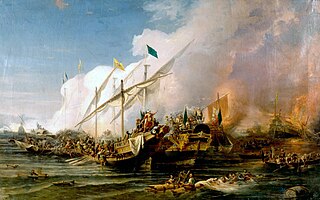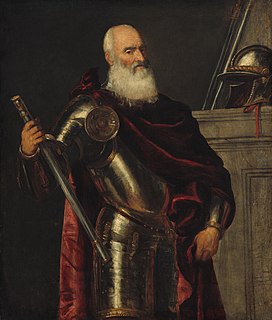For other alliances with similar names, see
Holy League.
The Holy League of 1538 was a short-lived alliance of Christian states arranged by Pope Paul III at the urging of the Republic of Venice.
In 1537 the Ottoman admiral Hayreddin Barbarossa, Pasha of Algiers, had captured the Venetian stronghold of Corfu and ravaged the coasts of Calabria. In the face of this threat Pope Paul succeeded in February 1538 in organizing the Holy League which consisted of the Papal States, the Republic of Venice, the Maltese Knights, the Spains and the Spanish ruled Naples and Sicily.
To confront Barbarossa and his roughly 120 galleys and fustas, the League assembled a fleet of 302 ships (162 galleys and 140 sailing ships) in September 1538 near Corfu. Its supreme commander was the Genoese admiral Andrea Doria, who was then in the service of Emperor Charles V.
The two fleets met on 28 September 1538 in the Battle of Preveza, and Barbarossa decisively defeated the numerically superior Christian alliance. Doria's leadership in the battle was less than vigorous and is widely believed to have been a major contributing cause to the League's defeat. His hesitation to bring his own ships into full action (he personally owned a number of them) and to sacrifice them for the good of Venice, the traditional rival of his home town of Genoa, are generally considered to explain his actions at Preveza.

The Battle of Lepanto was a naval engagement that took place on 7 October 1571 when a fleet of the Holy League, a coalition of Catholic states arranged by Pope Pius V, inflicted a major defeat on the fleet of the Ottoman Empire in the Gulf of Patras. The Ottoman forces were sailing westward from their naval station in Lepanto when they met the fleet of the Holy League which was sailing east from Messina, Sicily. The Spanish Empire and the Venetian Republic were the main powers of the coalition, as the league was largely financed by Philip II of Spain, and Venice was the main contributor of ships.

The Battle of Preveza was a naval battle that took place on 28 September 1538 near Preveza in Ionian Sea in northwestern Greece between an Ottoman fleet and that of a Holy League assembled by Pope Paul III. It occurred in the same area in the Ionian Sea as the Battle of Actium, 31 BC. It was one of the three largest sea battles that took place in the sixteenth century Mediterranean, along with the Battle of Djerba and the Battle of Lepanto. In this battle, the Ottomans defeated the Europeans.
Murat Reis the Elder was an Ottoman privateer and admiral, who served in the Ottoman Navy. He is regarded as one of the most important Barbary corsairs.

Occhiali was an Italian farmer, then Ottoman privateer and admiral, who later became beylerbey of the Regency of Algiers, and finally Grand Admiral of the Ottoman fleet in the 16th century.

The Battle of Djerba took place in May 1560 near the island of Djerba, Tunisia. The Ottomans under Piyale Pasha's command overwhelmed a large joint Christian Alliance fleet, composed chiefly of Spanish, Papal, Genoese, Maltese, and Neapolitan forces. The allies lost 27 galleys and some smaller vessels as well as the fortified island of Djerba. This victory marked perhaps the high point of Ottoman power in the Mediterranean Sea.

Hayreddin Barbarossa, also known as Hızır Hayrettin Pasha, and simply Hızır Reis , was an Ottoman corsair and later admiral of the Ottoman Navy. Barbarossa's naval victories secured Ottoman dominance over the Mediterranean during the mid 16th century.

Piali Pasha, was an Ottoman Grand Admiral between 1553 and 1567, and a Vizier (minister) after 1568. He is also known as Piale Pasha in English.

The Ottoman Navy, also known as the Ottoman Fleet, was the naval warfare arm of the Ottoman Empire. It was established after the Ottomans first reached the sea in 1323 by capturing Karamürsel, the site of the first Ottoman naval shipyard and the nucleus of the future Navy.
Kurtoğlu Muslihiddin Reis was the admiral of the Ottoman Empire, as well as the Sanjak Bey of Rhodes. He played an important role in the Ottoman conquests of Egypt (1517) and Rhodes (1522) during which he commanded the Ottoman naval forces. He also helped establish the Ottoman Indian Ocean Fleet based in Suez, which was later commanded by his son, Kurtoğlu Hızır Reis.
Salah Rais was the 7th King of Algiers, an Ottoman privateer and admiral. He is alternatively referred to as Sala Reis, Salih Rais, Salek Rais and Cale Arraez in several European sources, particularly in Spain, France and Italy.

The Fourth Ottoman–Venetian War, also known as the War of Cyprus was fought between 1570 and 1573. It was waged between the Ottoman Empire and the Republic of Venice, the latter joined by the Holy League, a coalition of Christian states formed under the auspices of the Pope, which included Spain, the Republic of Genoa, the Duchy of Savoy, the Knights Hospitaller, the Grand Duchy of Tuscany, and other Italian states.

The Franco-Ottoman Alliance, also known as the Franco-Turkish Alliance, was an alliance established in 1536 between the King of France Francis I and the Sultan of the Ottoman Empire Suleiman I. The strategic and sometimes tactical alliance was one of the most important foreign alliances of France, and was particularly influential during the Italian Wars. The Franco-Ottoman military alliance reached its peak around 1553 during the reign Henry II of France.

The siege of Corfu in 1537 was led by the Ottoman Emperor Suleiman the Magnificent, against the Republic of Venice-held island of Corfu. It is part of the Ottoman–Venetian War (1537–1540), one of the numerous Ottoman–Venetian Wars of the period.

The Third Ottoman Venetian War (1537–1540) was one of the Ottoman–Venetian wars which took place during the 16th century. The war arose out of the Franco-Ottoman alliance between Francis I of France and Süleyman I of the Ottoman Empire against the Holy Roman Emperor Charles V. The initial plan between the two had been to jointly invade Italy, Francis through Lombardy in the North and Süleyman through Apulia to the South. However, the proposed invasion failed to take place.

The siege of Castelnuovo was an engagement during the Ottoman-Habsburg struggle for control of the Mediterranean, which took place in July 1539 at the walled town of Castelnuovo, present-day Herceg Novi, Montenegro. Castelnuovo had been conquered by elements of various Spanish tercios the year before during the failed campaign of the Holy League against the Ottoman Empire in Eastern Mediterranean waters. The walled town was besieged by land and sea by a powerful Ottoman army under Hayreddin Barbarossa, who offered an honourable surrender to the defenders. These terms were rejected by the Spanish commanding officer Francisco de Sarmiento and his captains even though they knew that the Holy League's fleet, defeated at the Battle of Preveza, could not relieve them. During the siege, Barbarossa's army suffered heavy losses due to the stubborn resistance of Sarmiento's men. However, Castelnuovo eventually fell into Ottoman hands and almost all the Spanish defenders, including Sarmiento, were killed. The loss of the town ended the Christian attempt to regain control of the Eastern Mediterranean. The courage displayed by the Old Tercio of Naples during this last stand, however, was praised and admired throughout Europe and was the subject of numerous poems and songs. Even the Venetian refused the promised naval link to Castelnuovo with the supplies and reinforcements; after a general troop parliament, the commanding officer Francisco de Sarmiento asked his captains what his answer should be to Barbarossa's offer to surrender. The captains responded: "Que vengan cuando quieran".

Dragut, known as "The Drawn Sword of Islam", was a Muslim Ottoman naval commander, governor, and noble, of Turkish or Greek descent. Under his command, the Ottoman Empire's maritime power was extended across North Africa. Recognized for his military genius, and as being among "the most dangerous" of corsairs, Dragut has been referred to as "the greatest pirate warrior of all time", "undoubtedly the most able of all the Turkish leaders", and "the uncrowned king of the Mediterranean". He was described by a French admiral as "A living chart of the Mediterranean, skillful enough on land to be compared to the finest generals of the time. No one was more worthy than he to bear the name of king".

The siege of Corfu took place on 8 July – 21 August 1716, when the Ottoman Empire besieged the city of Corfu, on the namesake island, then held by the Republic of Venice. The siege was part of the Seventh Ottoman–Venetian War, and, coming in the aftermath of the lightning conquest of the Morea by the Ottoman forces in the previous year, was a major success for Venice, representing its last major military success and allowing it to preserve its rule over the Ionian Islands.

The Battle of Girolata was a naval action fought between Genoese, Spanish, and Ottoman ships on 15 June 1540 in the Gulf of Girolata, on the west coast of the island of Corsica, amidst the war between Charles V of Spain and Suleiman the Magnificent. A Spanish squadron of 21 galleys led by the Genoese Gianettino Doria and the Spaniard Berenguer de Requesens surprised an Ottoman squadron of 11 galleys, anchored at Girolata, led by the Ottoman admiral Dragut, whom the commander of the Ottoman Navy, Hayreddin Barbarossa, had committed to raid the Italian coast after his victories in the Adriatic sea the year before. As the crews of the Ottoman warships were ashore, distributing the booty from recent raids, the Spanish-Genoese fleet easily overtook them, taking all 11 Ottoman galleys and making 1,200 prisoners, among them Dragut, who was carried to Genoa and put, together with his captains, to row in Andrea Doria's galleys.

The Genoese navy was the naval contingent of the Republic of Genoa's military. From the 11th century onward the Genoese navy protected the interests of the republic and projected its power throughout the Mediterranean and Black Seas. It played a crucial role in the history of the republic as a thalassocracy and a maritime trading power.

Vincenzo Cappello was a Venetian nobleman and statesman, best known as the admiral of the Venetian navy in the Battle of Preveza.















